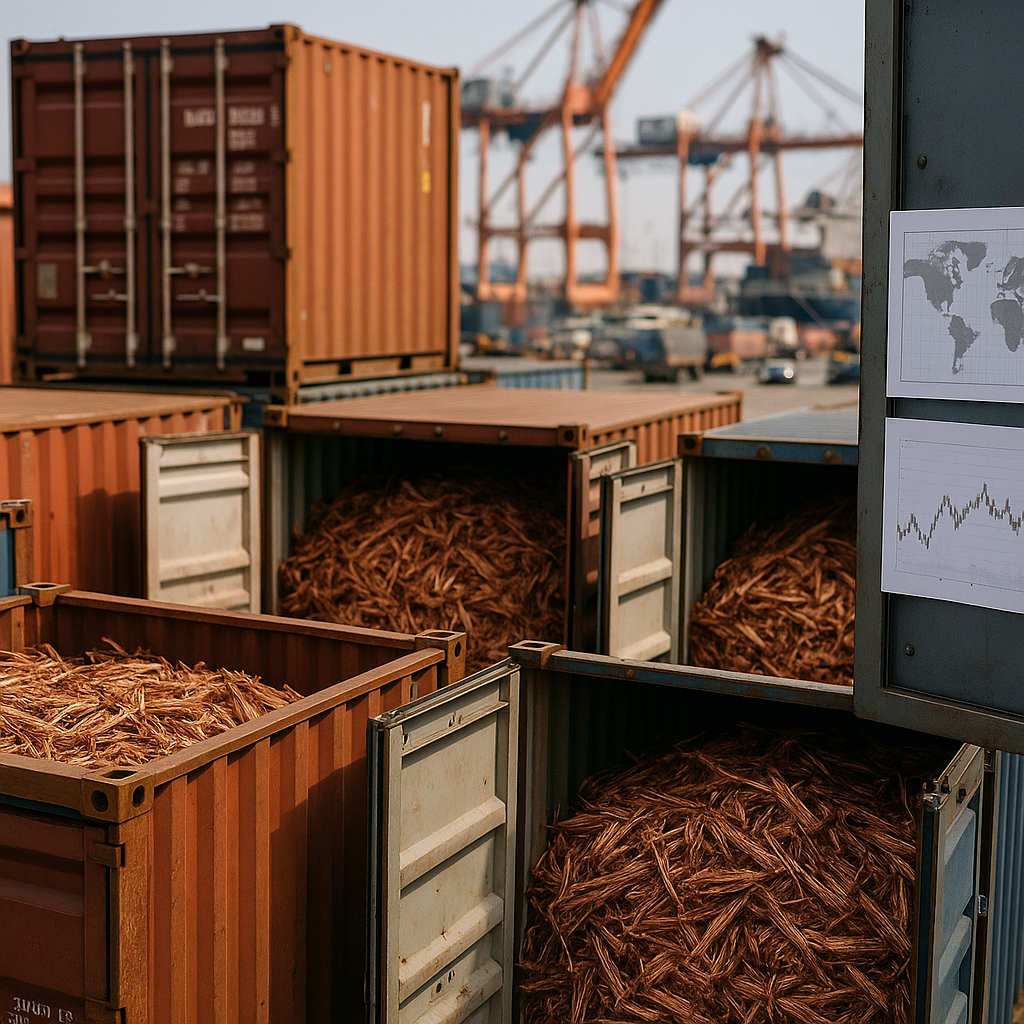5901 Botham Jean Blvd, Dallas, TX 75215
Current Copper Scrap Export Regulations Explained
May 30, 2025The United States faces a pivotal moment in its copper recycling industry. Currently, the country exports about 600,000 tons of copper scrap annually, making it the world’s largest exporter of this valuable recycled material. More than half of these exports go to China, forming a crucial link in the global copper supply chain.
The copper industry is advocating for a major policy change. Instead of imposing import tariffs on refined copper, industry leaders are proposing export restrictions on raw materials like copper scrap and concentrates. This strategy aims to strengthen the domestic supply chain.
The industry’s reasoning is clear. By retaining more copper scrap within U.S. borders, manufacturers could lessen their reliance on foreign refined copper. This retention of valuable scrap resources could potentially reduce costs for domestic manufacturers and encourage investment in local processing capacity. The strategy signifies a deliberate shift towards resource retention rather than traditional protectionist measures.
How are global markets affected by US copper scrap export policies?

A US scrap export ban would remove 600,000 tons of copper scrap annually from global markets. This volume represents about 5% of global mined copper production, creating significant ripple effects throughout international supply chains. The removal of such a substantial quantity would create an immediate supply gap in countries that rely heavily on US copper scrap imports.
China stands as the most vulnerable market to US export restrictions. As the largest importer of US copper scrap, China currently receives nearly 40% of all US copper scrap exports. Chinese buyers would face challenges securing alternative sources to replace this critical supply stream. Malaysia, which has recently increased its imports of US copper scrap by 8.56%, would also experience supply disruptions.
International copper prices would likely spike in response to export restrictions. Asian manufacturers, particularly those in electronics and construction sectors, would bear the brunt of these price increases. The price differentials between domestic US and international markets could range from 5-15% depending on how quickly global suppliers adapt to the new trade landscape.
Global scrap flows would undergo significant restructuring. With US material no longer available, Chinese and other Asian buyers would intensify competition for alternative sources from Europe, Latin America, and other regions. This would create a cascading effect on pricing across these secondary markets as well.
Domestically, US processors and manufacturers would experience contrasting effects. Copper scrap prices within the US would likely decrease due to increased local availability. This price advantage could benefit US manufacturers who use copper as an input material. However, the full realization of these benefits depends on whether US smelting and processing capacity can expand sufficiently to handle the increased domestic supply.
The current US domestic smelting infrastructure remains limited, with only three operational smelters. This processing bottleneck means that without significant investment in new capacity, the US might face challenges fully utilizing the retained scrap material. Some market analysts project that closed-loop recycling could eventually supply up to 40% of US copper needs, but this requires substantial infrastructure investment.
International trade relationships could also suffer collateral damage. Trading partners might implement retaliatory measures against US exports in other sectors. This diplomatic fallout could potentially undermine long-term strategic interests beyond just the copper market.
For global commodity markets beyond copper, export restrictions could set a concerning precedent. Similar policies might emerge for other critical minerals, further fragmenting global supply chains along geopolitical lines. This trend toward resource nationalism runs counter to decades of globalized trade in commodities.
| Market | Impact |
|---|---|
| China | Largest importer of US copper scrap; faces challenges in securing alternative sources. |
| Malaysia | Recently increased imports of US copper scrap by 8.56%; would experience supply disruptions. |
| International Prices | Likely to spike, affecting Asian manufacturers, particularly in electronics and construction sectors. |
| US Domestic Market | Potential decrease in copper scrap prices due to increased local availability; benefits depend on expanded smelting capacity. |
| Global Trade | Significant restructuring as buyers seek alternative sources from Europe, Latin America, etc. |
The timing of any policy implementation would significantly influence market reactions. A sudden ban would cause more dramatic price volatility than a phased approach that allows market participants to adjust gradually. Either way, the global copper market would need to adapt to a fundamentally altered trading landscape if US export restrictions were implemented.
What are the proposed alternatives to export restrictions?

As governments worldwide increasingly implement export restrictions on critical materials, industry stakeholders have developed several alternative approaches that could maintain supply chain security while avoiding the market distortions caused by conventional export taxes and bans. These proposed alternatives focus on incentivizing domestic production while ensuring manufacturers retain access to essential materials.
The mining and metals sector has been particularly active in proposing alternatives that would achieve governmental objectives without disrupting global supply chains. These proposals aim to balance national security concerns with economic efficiency and environmental goals.
Tax Credit Mechanisms
Production tax credits represent one of the most widely supported alternatives to export restrictions. Similar to those in renewable energy sectors, these credits would provide financial incentives to companies that establish or expand domestic mining and processing operations.
Tax credits work by reducing the tax burden on qualifying companies based on their production volumes. This approach helps offset the higher operational costs often associated with domestic production while avoiding market distortions caused by export taxes. Unlike export restrictions, tax credits don’t artificially lower domestic prices or reduce global supply.
Streamlined Permitting Processes
Fast-tracked mine permits address one of the primary challenges facing domestic materials production. In many jurisdictions, obtaining permits for new mining operations can take 5-10 years, creating significant barriers to expanding domestic capacity.
Industry leaders advocate for streamlined permitting processes that maintain environmental standards while reducing administrative delays. These reforms would help close the gap between domestic demand and supply without resorting to export controls that can trigger retaliatory measures from trading partners.
Adjusted Emissions Standards
Relaxed emissions standards for smelters and processing facilities represent another alternative approach. Modern metallurgical operations face stringent environmental regulations that can make domestic processing economically unviable compared to operations in countries with less rigorous standards.
Proposals in this area typically call for temporary adjustments to emissions requirements during facility construction or expansion, rather than permanent reductions in environmental protections. These temporary allowances would enable companies to establish domestic processing capacity more quickly while developing cleaner technologies for long-term operations.
Public-Private Partnerships
Some companies have proposed public-private partnerships (PPPs) to develop next-generation hydrometallurgical processing facilities. These partnerships would combine government funding and resources with private sector expertise to establish more efficient and environmentally sustainable processing operations.
PPPs could accelerate the development of advanced processing technologies that reduce environmental impacts while increasing domestic capacity. Government involvement helps mitigate financial risks associated with developing new technologies, while private sector participation ensures commercial viability.
Raw Material Exemptions
The Copper Development Association and similar industry groups advocate for targeted exemptions on raw materials, including cathodes and scrap. This approach would maintain export restrictions on some materials while ensuring manufacturers retain access to essential inputs.
Exemptions could be structured to allow the export of specific forms of materials needed by manufacturers while restricting the export of others. This targeted approach aims to protect domestic manufacturing while avoiding the broad market distortions caused by comprehensive export bans.
Each of these alternatives addresses different aspects of the challenges posed by export restrictions. By combining multiple approaches, policymakers could develop comprehensive strategies that protect national interests without disrupting global trade or triggering retaliatory measures.
| Approach | Description |
|---|---|
| Tax Credit Mechanisms | Provides financial incentives to companies establishing or expanding domestic operations, offsetting higher operational costs. |
| Streamlined Permitting Processes | Reduces administrative delays for new mining operations to expand domestic capacity. |
| Adjusted Emissions Standards | Temporarily relaxes emissions standards to allow faster establishment of domestic processing facilities. |
| Public-Private Partnerships | Combines government and private sector resources to develop efficient and sustainable processing facilities. |
| Raw Material Exemptions | Allows targeted exemptions for essential raw materials while maintaining restrictions on others. |
When evaluating alternatives to export restrictions, policymakers must consider both immediate supply needs and long-term economic development goals. While export restrictions may provide short-term relief for domestic manufacturers, they often lead to market distortions and reduced global economic welfare. The alternatives proposed by industry stakeholders aim to achieve similar policy objectives with fewer negative consequences.
How do international partners view US copper scrap export regulations?

Chile, which supplies 25% of US cathode imports, has formally opposed the proposed export restrictions. The Chilean government has issued strong warnings about potential diplomatic and trade repercussions if these measures are implemented. Chilean officials emphasize that such restrictions would disrupt the carefully balanced trade relationship between the two nations.
The interdependence of North and South American supply chains forms the core of Chile’s argument against these regulations. As Paula Estevez, CEO of the American Chamber of Commerce in Chile, notes, the copper trade between the two countries represents a mutual benefit rather than a one-sided advantage. This perspective underscores the deeply interconnected nature of global copper markets.
US export restrictions would likely trigger significant market restructuring. The Chilean Copper Commission (Cochilco) has announced contingency plans to increase scrap imports from Europe by 200% if US export curbs become reality. This immediate pivot demonstrates how quickly global supply chains can adapt to policy changes from major market players.
Perhaps most concerning for US policymakers is Chile’s warning that restrictions could divert Chilean copper to Asian markets. With China already receiving 53% of Chile’s copper exports compared to the United States’ 11.3%, any policy that pushes more Chilean copper eastward could further strengthen China’s position in global copper markets. This potential shift highlights how trade barriers often create unintended consequences in today’s interconnected economy.
The situation is complicated by existing trade agreements. Since 2004, Chile and the US have maintained a Free Trade Agreement that generally prohibits new trade barriers. This legal framework may provide Chile with grounds to challenge any new restrictions through formal trade dispute mechanisms.
Peru joins Chile in expressing concerns about potential US export restrictions. Together, these two nations supply 80% of the refined copper imported by the US, giving their opposition significant weight in any policy discussions. Their coordinated response demonstrates how supply chain partners can align their positions when facing disruptive policy changes.
Conclusion: The future of copper scrap export regulations

The US copper industry’s push for export restrictions marks a strategic shift in national resource management. Instead of broad import tariffs, the focus is now on retaining valuable copper scrap domestically. This strategy aims to reduce reliance on foreign refined copper and build domestic processing capabilities. Success depends on significant investments in US smelting and refining infrastructure to effectively process retained materials.
As global copper demand rises, driven by electrification and renewable energy expansion, securing stable supply chains is critical. The narrowing US-LME price premium suggests cautious market optimism, but volatility may persist until regulations are finalized. For businesses navigating these uncertainties, staying informed about regulatory developments and adapting supply chain strategies accordingly is crucial. Contact Okon Recycling at 214-717-4083 for expert guidance on copper recycling needs and compliance with evolving regulations.
